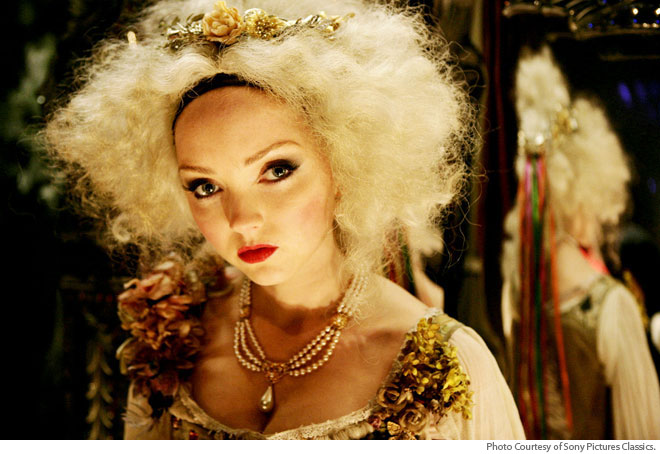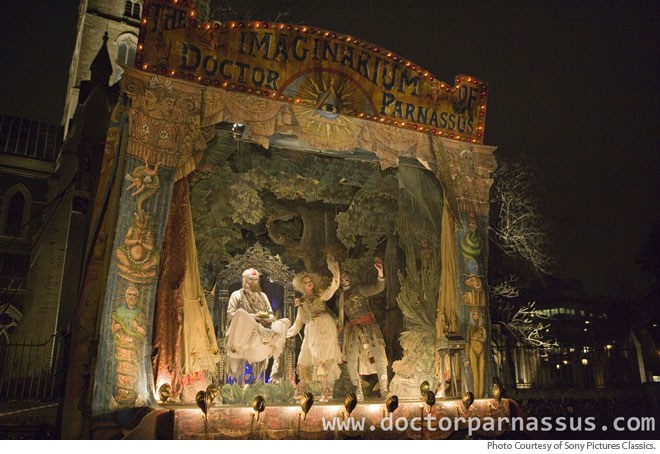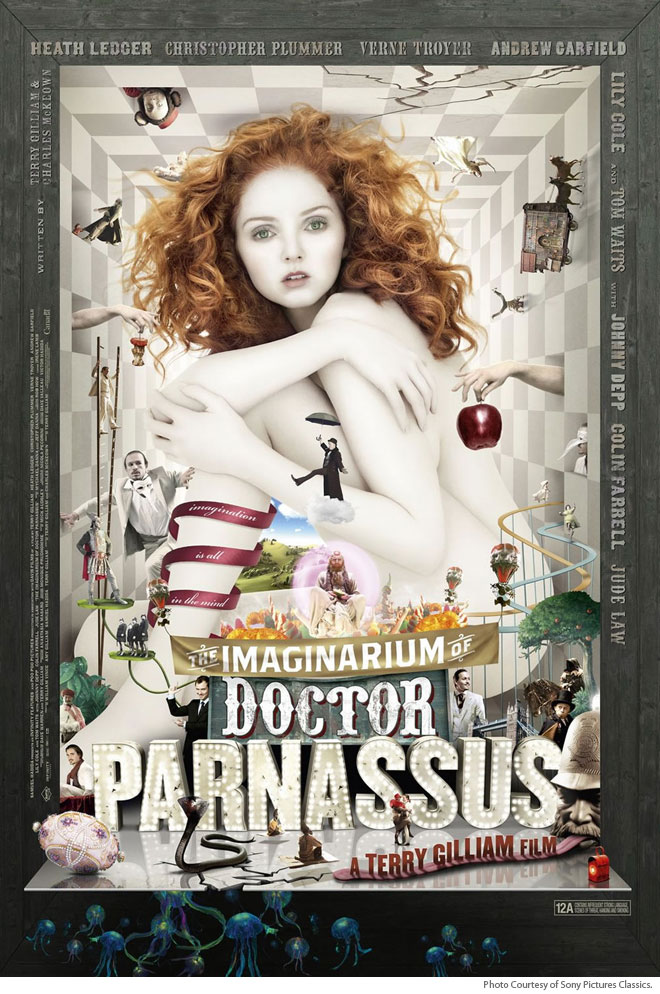Watching Terry Gilliam’s The Imaginarium of Dr. Parnassium is a bit like a date in the Museum of Modern Art without a guide book or headset. Just when you think you have a grasp on the intention behind one canvas, your companion pulls you toward another, then another, and another, until all whirl together like faces in a carousel in an Orson Welles movie.
Gilliam, whose visual genius provided a backdrop to the zany classic Monty Python’s Flying Circus, has not achieved that level of popularity in his own films, where his self-indulgent tendencies muddle many filmgoers, and thus put pressure on producers who like a few coins in the salver at the end of the day. The more successful ventures like 12 Monkeys (1995) and Brothers Grimm (2005) are anchored in plot material that moves more or less in a definable line from point to point. Trouble for the average viewer occurs when Gilliam’s plot is more unevenly lined, as in Brazil (1985) and The Adventures of Baron Munchausen (1988).

The Imaginarium of Dr. Parnassus, a film in which the plot line seems to have been drawn by several hands using all different utensils, is the perfect storm of the best and worst of the director. Circumstances, however, should incline us to be considerate regarding the film’s weaknesses, for this was the film Heath Ledger was working on at the time of his death. Gilliam had begun The Imaginarium in 2007 and picked it up again after Ledger passed at the insistence of friends who wanted the young actor’s memory preserved and honored. The plot line, therefore, was indeed drawn with different utensils to accommodate the need to make changes to Ledger’s character and the story to fit the existing footage. The result is more Terry Gilliam visual genius and inventiveness masking a difficult story made less easily discernible by problems in production. Take The Imaginarium of Dr. Parnassus as an interesting artifact given those conditions, accept the murky plot and several transitional gimmicks as necessary adjustments, and enjoy the visual and imaginative display—that would be good advice. And don’t take a date unless you both share a fondness for the kind of friend who wears black canvas tennis shoes to a formal dinner.
Dr. Parnassus (Christopher Plummer), a decrepit magician, runs an anachronistic traveling stage show that he parks in seedy corners of London in the hope of luring patrons into a magic mirror world that promises to satisfy all their private fancies. His entourage includes his newly blooming daughter Valentina (Lily Cole), a dwarf named Percy (Verne Troyer), and a barker named Anton (Andrew Garfield). Predictably the dwarf watches over Dr. Parnassus, while Anton watches over Valentina, so to speak. Less predictably, Dr. Parnassus has made a pact with Lucifer, played by Tom Wait as an old, Chicago-style bookie in a bowler hat. The pact is Faustian, granting Parnassus eternal life in exchange for the soul of his daughter on her sixteenth birthday. Problems always arise with those who trust the devil. Here, Parnassus, like Tithonus, has seemingly forgotten to ask for eternal youth along with immortality; thus, he is supremely grotesque, especially when caked with show paint. In addition, he bargained on not having a child—surprise. So, as the story begins, Valentina is a few days from sixteen and her own date with the devil, and Parnassus is left to counter-bargain to save her, that counter being that he find five other souls willing to be damned in exchange. (Theologians should hold off their own temptation to scrutinize too closely this moral conundrum.)
Enter the Heath Ledger character, Tony. Valentina and company find him hanging from a bridge and perform a heroic rescue, unfortunately more worthy an act than he deserves. Tony turns out to be a scammer who got on the bad side of the mob for some altruistic swindle he maneuvered at their expense. This he does not reveal to the company, which he joins and tries to assist. Here the plot becomes complex beyond description, going in three separate directions at once—Parnassus’ race with the devil’s clock; a love triangle with Valentina, Tony, and Anton; and a Dante-esque journey into the individual fantasies of those who willingly or unwillingly enter the world of Parnassus’ mirror. Bottom line is Valentina has to be saved (apparently so she can go off into her own suburban fantasy life), Parnassus freed from his infernal pact, and Tony revealed in his true colors. It should be noted here that three separate actors are used to play Ledger’s part as Tony leads different lost souls into and through the mirror world—Johnny Depp, Jude Law, and Colin Farrell; a confusion born in tragedy that turns the mirror-world fantasies into surrealist art of a very high order, with layer upon layer of possible meanings, none of which carry through consistently, but all of which suggest themes that might.

It is this suggestion of higher themes that makes The Imaginarium of Dr. Parnassus more than a grotesque sideshow of its own. You never get deeply enough involved with individual characters to care much for their plight, but the film does succeed in painting great interest around drawing-room matters, such as modern materialism and modern sentimentality, Hollywood-style exploitation, and the heavens and hells men conceive in their minds.
Putting the best construction on all of this, the film should be taken as autobiographical parable of the artist, Gilliam, struggling to enhance human imagination and true expression, while trapped in a pact with investors and producers who want paying customers who promise to come back. In one telling segment, Tony convinces Parnassus to modernize the traveling show, preying on the magician’s desperation to find souls willing to be damned in order to save Valentina. This results in a new tacky version of the stage set up in a shopping mall, led by a slick Tony, Anton now in drag, Percy in black face, and Valentina in long hair, only. When female shoppers stream into the mirror, they find shabby, slick fantasies of soap opera dreams that tempt and damn them. The point is clear enough. Gilliam, like so many independent and original artists caught in the film-making machine, has long been in battle with the middle-managers of the market forces that pull him from himself; more simply, the market has tempted this film artist’s integrity. Parnassus makes a profit with Tony’s compromises, but souls are lost in the process. (Oddly, from the other side of the argument, those souls are lost in so visually inventive a process in the mirror world, that the losses seem almost satisfying, not tragic. The same corrupting business machine that encourages him to compromise as a filmmaker at least allows Gilliam to make and distribute his films. And Gilliam should be seen and appreciated, for in his purest he is an absolutely dazzling visual artist with incredible insights into the human condition, particularly our condition in this wheezing modern world we currently stumble through.)

The Imaginarium of Dr. Parnassus has very few comparables. The tacky grotesques that populate many scenes bring to mind Baz Luhrmann’s Moulin Rouge! (2001), but Gilliam’s film has far more intellectual heft and visual effect. The parabolic quality of the film’s reflection on the function of art and the vanity of man conjures Anton Walbrook in Max Ophuls La Ronde (1950). Here again, however, Ophuls and Gilliam have entirely different temperaments, so a comparison seems unfair. To measure The Imaginarium to other Gilliam films is similarly problematic because of the practical challenges following Heath Ledger’s death. Film is a complex enough artistic business given the number of hands and minds involved in the creative enterprise, and this particular film went off the chart once the decision was made to go ahead with the production. So, The Imaginarium needs to be taken as its own unique enterprise and appreciated in the most basic of ways. That is, it is the subject of its own conversation, artist to spectator, a wonderfully innovative ramble on a wide range of topics, centered around art, which is the very experience of the conversation itself.
Follow that? It’s the kind of baroque logic Gilliam evokes, and most enjoys. Despite the challenge, this conversation certainly is a far cry more interesting than Hollywood elites telling us how to think and feel about the subjects the Academy deems as important. Is it not?
